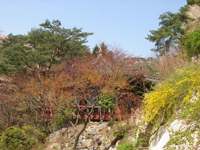
Spring at Samcheonggak is an artist's palette
Springtime is definitely one of Korea's best seasons. The weather is almost ideal, and the mountains are lush with green vegetation and colorful flowers on trees. Although cherry blossom season is over, there is still much to see.
One of Seoul's best places to visit has to be Samcheonggak, even though it is perhaps not as famous as it should be. This author had lived in Korea for many years before finally paying a visit last week, and he regretted all those lost years of ignorance of this delightful treasure, only a short taxi or shuttle bus ride from the heart of Seoul.
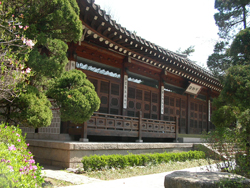
Cheonchu-dang: Pres. Park's favorite
First, some history. Samcheonggak was built in 1972 as a venue for Red Cross representatives from North and South Korea to wine and dine after their meeting together in Seoul.
This was the first official meeting of any kind between the two Koreas, coming 19 years after the ceasefire of the Korean War was signed, and only four years after an attempt was made on South Korean President Park Chung-hee's life by a group of North Korean commandos.
The resulting 1972 communique, announcing in part that both Koreas were committed to a future unification and laying the groundwork for future family reunions, was an important step forward in North-South relations.
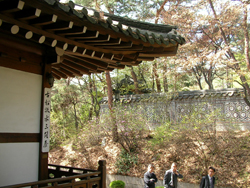
Samcheonggak is built on Bugaksan (Mt. Bugak) along the picturesque Bugak Skyway, surely the most scenic drive in all of Seoul. It is not one building but six, nestled in a pine forest on the mountainside behind the presidential residence Cheong Wa Dae. The name Samcheonggak itself means pavilion of three pure things, namely pure water, pure mountains and pure humanity.
Constructed using modern materials but in the style of a traditional Korean "yojeong," where female dancers called gisaeng would entertain male diners, Samcheonggak was long kept closed to the public and used only by high-ranking politicians.
Some time after President Park's death in 1979, the restaurant was sold to a private owner, and turned into an opulent restaurant for wealthy businessmen. Ultimately, in 1999, Samcheonggak as a private concern could no longer make money, and it closed down.
The property was sold and was slated for demolition and redevelopment as luxury mountainside residences. It is hard to believe, but this historically important and beautiful place was almost lost forever.
It was at this point that Seoul Metropolitan Government took control of it, in order to preserve its historic character for future generations. Seoul turned over ownership of the property to the same foundation that runs the Sejong Cultural Center, who in 2005 awarded a contract to the Paradise Hotel to manage the facility.
The largest of the six Samcheonggak buildings is called Ilhwa-dang (meaning "convergence into one"). It holds a restaurant serving high class Korean lunches and dinners made with all natural ingredients. It can seat up to 120 guests and there are also private rooms available upon reservation.
Upstairs there is a lounge and wine bar for a more relaxed style. In springtime, a table on the open wooden balcony facing the mountains and looking down into Seongbuk-dong is an absolute delight, and even makes the coffee served at hotel prices seem reasonable. The bar-lounge is open until midnight, so you can sit here admiring the day- and nighttime view.
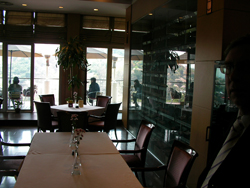
The lounge and wine bar in Ilhwa-dang
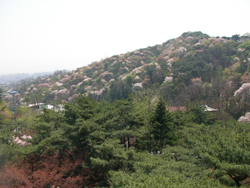
The view from the balcony is a rare treat
Samcheonggak also hosts weddings and banquets. On the day this author visited, one of the smaller buildings named Cheongcheon-dang (meaning "place where there is spring water") was having some kind of luncheon party for a group of Japanese people, complete with a performing musical trio in the garden.
Another building was the venue for a lady's 70
th birthday party (a big event in a Korean person's life). Food is catered by the Paradise Hotel, and their advertising literature boasts that they also host corporate events, conferences, seminars, product launches, parties and of course weddings (for a maximum of 300 guests).

Interior and exterior shots of Cheongcheon-dang, often used for events and parties
Next to Cheongcheon-dang stands Cheonchu-dang (meaning "deep blue skies above"), which was apparently once the late President Park's favorite place in Samcheonggak to eat, drink and be entertained with his closest aides. Like the other buildings, it is designed to look like a traditional Korean house, or Hanok, and is nestled in amongst trees and greenery.
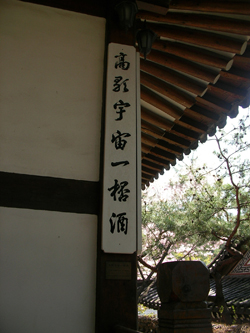
Eulogizing the universe, I have a drink
Each of the smaller buildings features proverbs and sayings in Chinese calligraphy painted on white boards and hung on either side of every door and on the corner posts. Luckily for those of us without a classical Eastern education, each of the quotations are translated into both Korean and English. This author's personal favorite is "Eulogizing the universe, I have a drink." What a lovely sentiment – I'll drink to that.
As well as the buildings themselves, the gardens around each of them are the perfect place for some springtime photography and nature-watching. There is even a path through the pine forest running between some of the buildings and the main entrance. It's an ideal location for a meditation, a quiet chat or a sylvan rendezvous. The best thing is that a walk around Samcheonggak is completely free. There is no entry fee to the property and no obligation to go in and order food or drink.
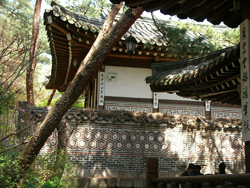
In recent years Samcheonggak hosted daily musical performances and offered opportunities to visitors to experience various aspects of Korean traditional culture.
However, these programs appear to have stopped at least for the moment, and a source stated there are no plans to bring them back. The English website for Samcheonggak has not been updated, and still shows these programs as if they were currently ongoing.
Later this year, the Sejong Cultural Foundation is due to resume direct management of Samcheonggak, and exactly what kind of venue it will become is not yet clear. One thing is for certain: the historical, cultural and esthetic value of this place has been recognized, and access to the public will remain open. This author thinks it would be an ideal location for a social club.
How to get to Samcheonggak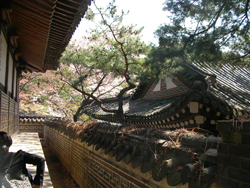
If you have your own car, chances are you will be familiar with Bugak Skyway, the road that takes you from Samcheong-dong (to the east of Gyeongbok Palace) past the Prime Minister's residence, up Samcheong hill and through Samcheong Tunnel all the way to Hyehwa-dong and Seongbuk-dong. If you turn left just after leaving Samcheong Tunnel, you will arrive at Samcheonggak.
For those without a car, there is a shuttle bus that runs from 10 a.m. to 9 p.m. There are stops at the east gate of Gyeongbok Palace, Jogyesa Buddhist Temple, exit 5 of Jonggak subway station (line 1, in front of Younpoong Bookstore), exit 1 of Euljiro1ga subway station (line 2), in front of the Press Center Building and also in front of the Kyobo Building/exit 3 of Gwanhwamun subway station (line 5). A schedule can be seen here, but is subject to change, and a map is at the bottom of this page. Call 02-765-3700 for more information (Korean and limited English spoken).
The website of Samcheonggak is here (in Korean, English and Japanese, but the English site has not been updated for some time).
By Jacco Zwetsloot
Korea.net Staff Editor & Writer